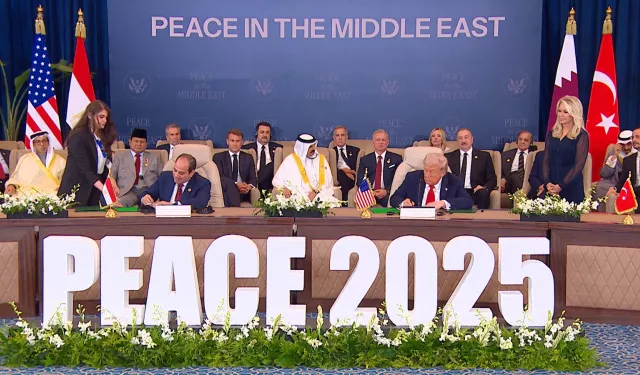US President Donald Trump on Monday signed a multilateral agreement to end Israel’s war on Gaza, alongside Egyptian President Abdel Fattah El-Sisi, Turkey's Erdoğan, and Qatar’s Emir Sheikh Tamim at the Sharm El-Sheikh summit.
Trump arrived nearly three hours late after delivering a speech to the Israeli Knesset, where he expressed unwavering support for Israel and Prime Minister Benjamin Netanyahu. He boasted that the US “makes the best weapons in the world,” and that Israel “used them very well”, enabling Israel to become “strong and powerful, which ultimately led to peace”.
Referring to the Al-Aqsa Flood operation, he said, “never forget, never again,” and affirmed that Israel has achieved “all that it can through force of arms.”
Earlier in the day, prior to the captive exchange between Palestinian resistance groups and Israel, Hamas had reiterated that Israel failed to retrieve its captives through military means “despite intelligence superiority and firepower,” and was ultimately forced to accept an exchange deal, “just as the resistance promised.”
In Sharm El-Sheikh, Trump met with El-Sisi in a bilateral session attended by journalists. He applauded the Egyptian leader’s role in brokering a ceasefire, calling him “a great leader.” El-Sisi replied, “I was sure you were the only one capable of achieving peace in our region.”
Asked about post-agreement developments, particularly the fate of missing Israeli captives, Trump said recovery efforts were ongoing. “They don’t know exactly where they are,” he said. “I think about six bodies have been recovered so far, and the search continues.”
During the peace summit, Trump confirmed that Phase Two of the Gaza agreement had already commenced, emphasizing overlapping timelines and the scale of reconstruction. “Gaza’s recovery will require enormous efforts in clearing rubble and debris,” he said.
He hailed the attendance of the world’s wealthiest nations as proof of global commitment and praised the participation of more than 35 invited states.
Trump also referenced his long-standing rapport with El-Sisi, recalling their 2016 meeting before his election win over Hillary Clinton. “We had a very good chemistry together, and it continues till today.”
Following the ceremony, El-Sisi delivered a speech expressing hope that the agreement would pave the way for a two-state solution, calling it “the only path to fulfilling the legitimate aspirations of both Palestinians and Israelis for peace and security.”
Trump, however, both in his remarks and in the “The Trump Declaration for Enduring Peace and Prosperity,” failed to explicitly address the issue of one or two states. The declaration signed by the four leaders reads, “We understand that lasting peace will be one in which both Palestinians and Israelis can prosper with their fundamental human rights protected, their security guaranteed, and their dignity upheld.”
When pressed by reporters regarding the long-term solution, Trump stated aboard Air Force One that he would “decide what I think is right,” noting that some people favor a one-state solution while others prefer the two-state model. This non-committal stance reflects a divergence from decades of bipartisan US foreign policy that had explicitly championed the two-state solution.
El-Sisi urged that “this war on Gaza be the last war in the Middle East,” and reaffirmed Egypt’s plan to host a recovery and reconstruction conference. “Our goal is to restore life to the Palestinians on their land and give them hope,” he said.
Trump then described the deal as a “historic agreement” and “a major leap toward peace and prosperity in the Middle East.” He urged broader support for the Abraham Accords, claiming that four of the world’s richest nations had already joined, and criticized the Biden administration for what he called “neglect” of the accords.
He also called on Palestinians in Gaza to “focus on providing the essentials of life,” and said that multiple parties had expressed willingness to contribute to rebuilding efforts. “There will be a lot of money flowing in,” Trump added.
